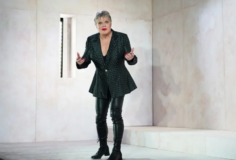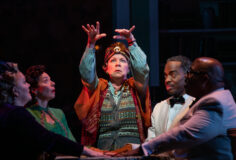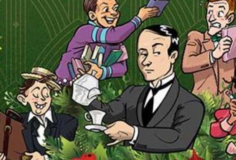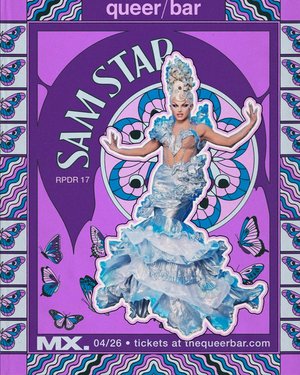Review: Clybourne Park by Bruce Norris. Directed by Braden Abraham. With Aaron Blakely, Suzanne Bouchard, Teagle F. Bougere, Peter Crook, Ashton Hyman, Marya Sea Kaminski, Darragh Kennan, Kim Staunton. Now through May 13, 2012 at Seattle Rep.
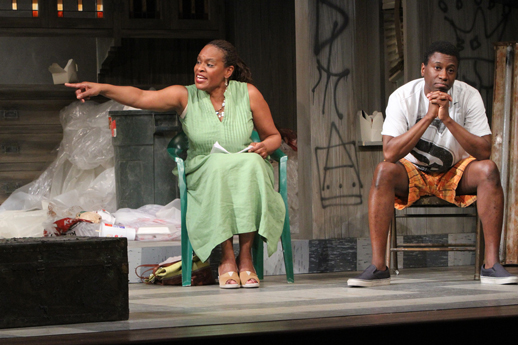
(l to r) Kim Staunton and Teagle F. Bougere star in the Pulitzer Prize winning play Clybourne Park at Seattle Repertory Theatre. Photos by: Alan Alabastro
Seattle Rep’s production of Bruce Norris’s “Clybourne Park” has quite a pedigree. It’s a multi award winning new play, (including last year’s Pulitzer Prize for Drama) and the plot is “suggested” by the classic 1959 drama by Lorraine Hansberry, “A Raisin in the Sun”. It has an all-star cast of familiar Seattle actors and has been given a lavish production by the Rep including an impressive set (and set change) by Scott Bradley. After successful runs in London, off-Broadway and at regional theaters around the country, the play just opened to strong reviews on Broadway, and is considered a front runner for this year’s Tony Award for Best Play.
“Clybourne Park” is frequently funny and occasionally poignant. The strong 8 member cast give strong performances. The design elements are superb, particularly the aforementioned set design by Mr. Bradley. The writing, on occasion, has wit and charm. And, the play is certainly cleverly conceived and obviously has a topical value.
It’s also a rather shallow look at race relations and it’s about as profound as a “Very Special Episode” of the sitcom of your choice. The play references Ms Hansberry’s beautiful play, but it never reaches the lyrical heights of that work. It doesn’t innovate, or challenge, or really bother to explore all the very interesting and provocative issues it raises. “Clybourne Park” deals with race, real estate, gentrification, money and the politics of property, but it only scratches at the surface of those fascinating topics. Yes, it has some lovely moments, but the moments never really add up to much and frankly, most of the characters are a bit superficial and bordering on caricature. And, the pacing of the play is odd and off-putting with long vapid stretches of meaningless moments and banter. The few powerful moments of the script never outweigh its inherent weaknesses. “Clybourne Park” is an example of the irritating phenomenon of plays/books/films/art of any kind that becomes popular because someone deems it “timely and important” and the majority of the critical masses feel compelled to jump on the bandwagon because how can you possibly dislike something that won the Pulitzer, or the Oscar, or the Booker? It MUST be brilliant art! Only a philistine would think otherwise!
I guess I’m a philistine.
But, I will give kudos to Mr. Norris for the concept. “Clybourne Park” is a companion piece to Ms Hansberry’s “A Raisin in The Sun”, her lovely and semi-autobiographical play about an African-American family in 195o’s Chicago who inherit a large sum of money that could help each member of the Younger family achieve their dreams. The matriarch of the family eventually ends up buying a new home for them all…in the all white neighborhood Clybourne Park. A representative from that neighborhood’s resident association comes to buy them out, but the family is determined to better themselves and as that play ends, the family prepares for the next stage in their lives.
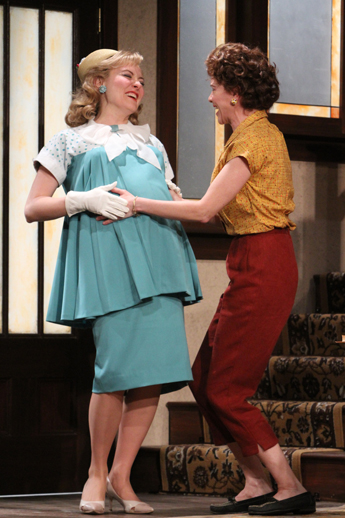
(l to r) Marya Sea Kaminski and Suzanne Bouchard star in the Pulitzer Prize winning play Clybourne Park at Seattle Repertory Theatre. Photos by: Alan Alabastro
“A Raisin in the Sun” never actually portrays the new home and Mr. Norris’s play isn’t a sequel to that work. The first act of “Clybourne Park” takes place roughly concurrently with the events of “Raisin” and focuses on the white family that are selling their home to the Youngers much to the horror of their neighbors. Bev and Russ are a middle aged, middle class couple coping with the recent suicide of their emotionally crippled, war veteran son Kenneth, and are anxious to make a new start with their own lives as they cope with that loss. During their final weekend in the house as they pack up, the couple deal with that tragedy in different ways, and the repercussions of the selling of the house, have on their African American maid, Francine; her husband Albert; the local pastor, Jim and Karl, the character from “Raisin” who tries to convince the Youngers to not move to the neighborhood. (With, Karl’s deaf and pregnant wife Betsy also present for no apparent reason than to be mildly amusing and “different”. “Look! That’s a deaf pregnant lady who talks funny and serves no purpose at all to the narrative other than to be a visual punch line!!)
Act II picks up 50 years later with the same actors playing very different roles, (though, some of the 2009 characters do have connections to the characters from the first act). A yuppie white couple, Steve and his pregnant wife Lindsay have purchased the same, now dilapidated house and intend to tear it down to erect their own “Mini Mansion” which has raised concerns in the neighborhood as it undergoes its latest change from an all black neighborhood, to one rapidly being gentrified by an upper middle class anxious to live in a re-emerging neighborhood close to downtown Chicago. The current resident association has registered a complaint that the proposed new house will violate existing zoning laws, and on a steamy weekend afternoon, the couple meet with representatives from the city and neighborhood including local married couple Kevin and Lena, who as it turns out, is a niece of the Younger family and was an early witness to the difficulties the Youngers had as the first black family in Clybourne Park. The meeting ineffectively tries to convene, frequently interrupted by cell phones and workmen and eventually dissolves into chaos as questions of race, gender, and gentrification begin to emerge, (but never really develop beyond bad jokes and angry words, all unresolved). The play ends with a ghostly reminder of the past.
Of the two acts, I preferred the first, which is anchored by the very strong performances of Suzanne Bouchard as the sweet, but lost in grief, Bev, and Peter Crook as the husband, Russ, who hides his pain and anger behind a traditional male mask of denial. Both actors give exceptional depth and color to their characters, which are probably the best defined in the script. Kim Staunton as the maid Francine, and Teagle F. Bougere as her husband Albert, are also fine with less well defined roles; both characters are hampered by their character’s positions in the plot. As people of color, and servants, they are denied a full existence in the lives of their white employers, despite Bev’s meek attempts to reach out. The other actors, Aaron Blakely as the mealy mouthed local pastor, Jim; Darragh Kennan as the persnickity and determined neighborhood association member, Karl, and Marya Sea Kaminski as his deaf, pregnant wife are all excellent actors making the best of roles that are, in the case of Jim and the pregnant deaf wife, not particularly important to the plot. Mr. Kennan has the most important role of the three as he’s the link to “Raisin” and his stubborn confrontational stance leads to an emotional climax as the act ends. There’s a bit of unnecessary padding and prattling in Act I; I could have done without the loooooooong opening bit about geography and “Ulan Bator” and some of the characters serve little function, but the strength of the roles and performances by Ms Bouchard and Mr. Crook, and the journey they take, is powerful and moving.
Act II opens with a shock: the lovely Craftsman style home is now a graffiti covered shell of its former glory and the tone of the play and its characters have shifted dramatically. Characters both white and black are casually convened in the house and the atmosphere is decidedly less formal. Moving to the center stage are the Yuppie couple, Steve and Lindsey, played by Darrah Kennan and Marya Sea Kaminski, who while also coupled in Act I, and Ms Kaminski is pregnant in both acts, now play radically different characters. And, despite the huge talents of the two actors, the characters themselves are a bit of a cliche; hackneyed Yups who like to claim “Some of my best friends are black!” yet don’t seem to have much of a clue when it comes to the tensions caused by their tacky desire to build a Mega Mansion in the neighborhood.
Ms Bouchard is also fine in the much smaller role as the couple’s lawyer, Kathy (who also has a connection to Act I characters) and Mr. Blakely’s zoning official Tom is such a tiny role that it has no meaning in the context of the play, except for one funny, (and appropriate to this website) confession from the character during the heat of an argument. Both characters are apparently only present to fill up space; like some of the characters in the first act, they don’t have much to do. The same goes for Peter Crook’s astonishing transformation from the middle aged accountant Russ to his Act II character, Dan, a muscular, outgoing, native Chicagoan blue collar worker. Dan has little to do, but like the set change, the transformation of the actor from Act to Act is part of the show. But, to what purpose, other than a chance for the audience to exclaim, “OOOOOH! What a change!”
But, stylistically and narratively, the largest change happens to the African-American characters played by Ms Staunton and Mr. Bougere. Their characters in Act I were subjected to servile social roles, though obviously chaffing at the constraints of living in the inequalities of that time. In the 2009 of Act II, Lena, the Younger niece, and her husband Kevin are living a life far different from their ancestors. Kevin is far more outgoing and friendly and very much more comfortable dealing with the situation while Lena is guarded and obviously a bit hostile to the changes happening to the house and the neighborhood as her character echoes the feelings of the white characters in Act I. And, while I very much like the performances of both these actors, (neither of them are local, but Ms Staunton was in Seattle last for Seattle Rep’s brilliant production of “Fences two years ago, and Mr. Bougere was a highlight in last year’s “Of Mice and Men”), their roles in the second act are never completely explored. Both Kevin and Lena feel like devices necessary to move the plot along despite the excellent performances of the two actors.
Actually, that’s the main problem with “Clybourne Park”, especially in Act II. Despite the affectations of having characters prattle about geography, or the irritations of modern cell phone usage, none of this feels very real or compelling. Yet, the subjects scratched at, in this play, ARE very real and compelling as neighborhoods just like Clybourne Park undergo gentrification and many different social groups are disenfranchised from their homes. It’s happening right now, in Seattle, and not just in “black neighborhoods” like the Central District but in Ballard, and Fremont, and Capitol Hill. The arguments in “Clybourne Park” are so facile that they never amount to much. And, the two main couples of Act II; Lena/Kevin and Steve/Lindsey, never amount to more than caricature and opportunities for bad jokes and fighting. There’s the basis for a great play about race and real estate in “Clybourne Park” but it never gets realized. The Emperor isn’t wearing any clothes, folks.
But, that set change WAS freakin’ AWESOME!


